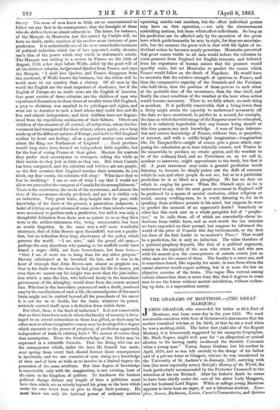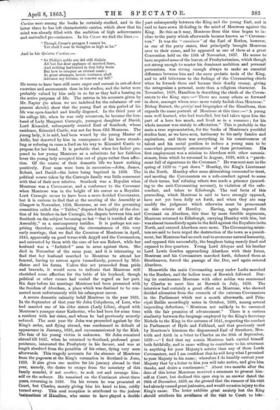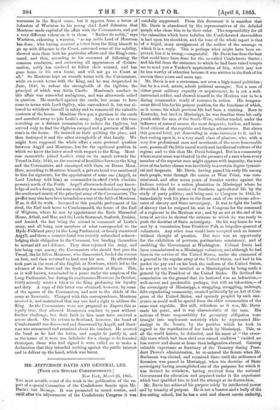THE GRAHAMS OF MONTROSE.—(THE GREAT MARQUIS.)
TAMES GRAHAM, who succeeded his father as fifth Earl of d Montrose, was born some day in the year 1612. We need not trouble ourselves with Scot of Scotstarvet's statements that his mother consulted witches at his birth, or that he ate a toad when he was a sucking-child. The latter fact (told also of the Regent Morton), it is humorously suggested by his energetic biographer, Mr. Mark Napier, might well pass for " an allegorical or cynical allusion to his having rashly swallowed the Scottish Covenant when a young man." Young James Graham lost his mother in April, 1618, and so was left entirely to the charge of his father and of a private tutor at Glasgow, whence he was transferred to the University of St. Andrew's in January, 1627, carrying with him (his tutor especially notes) Raleigh's History of the World, the book particularly recommended by the Protector Cromwell to the attention of his son Richard. After his father's death he seems. to have been chiefly under the care of his sister Lady Margaret, and her husband Lord Napier. While at college young Montrose appears to have been an eager, if not a laborious student. Xeno- phon, Seneca, Buchanan, Lucan, Cresar's Commentaries, and Quintus
Curtius were among the books he certainly studied, and in the latter three he has left characteristic entries, which show that his mind was already filled with the ambition of high achievements and unrivalled pre-eminence. In his Caesar we find the lines :—
" Though Cmsar's paragon I cannot be, Yet shall I soar in thoughts as high as he."
And in his Quintus Curtius
As Philip's noble son did still disdain All but the dear applause of merited fame, And nothing harboured in that lofty brain But how to conquer an eternal name ; So great attempts, heroic ventures, shall Advance my fortune, or renown my fall."
He seems to have been still more eager and earnest in out-of-door exercises and amusements than in his studies, and the latter were probably valued by him only in so far as they had a bearing on the active purposes of life. The entries in his accounts given by Mr. Napier (to whom we are indebted for the substance of our present sketch) show that the young Earl at this period of his life was open-handed and kindly disposed. In the third year of his college life, when he was only seventeen, he became the hus- band of Lady Margaret Carnegie, youngest daughter of David, Lord Kinnaird, subsequently created Earl of Southesk, whose residence, Kinnaird Castle, was not far from Old Montrose. The young lady, it is said, had been wooed by the young Master of Airlie, but deserted by him in consequence of his horse stumb- ling or refusing to cross a ford on his way to Kinnaird Castle to propose for her hand. It is probable that when her father pro- posed to her young Montrose as a substitute for her faithless lover the young lady accepted him out of pique rather than affec- tion. Of the course of their domestic life we know nothing positively. Four sons were born in succession—John, James, Robert, and David—the latter being baptized in 1638. The political course taken by the Carnegie family was little consonant with that of their new relative. Southesk was a Royalist when Montrose was a Covenanter, and a conformer to the Covenant when Montrose was in the height of his career as a Royalist. Lord Carnegie seems to have been a more decided Covenanter, but it is curious to find that at the meeting of the Assembly at Glasgow in November, 1638, Montrose, as one of the governing committee called the " Tables," disputed the legality of the elec- tion of his brother-in-law Carnegie, the dispute between him and Southesk on the subject becoming so hot " that it terrified all the Assembly," as a contemporary testifies. It is perhaps not sur- prising therefore, considering the circumstances of this very early marriage, that we find the Countess of Montrose in April, 1645, apparently on good terms with Argyll and the Covenanters, and entrusted by them with the care of her son Robert, while her husband was a " forfeited " man in arms against them. She died in November of the same year, and it is interesting to find that her husband marched to Montrose to attend her funeral, having to retreat again immediately, pursued by Mid- dleton and his forces. Unless this act proceeded from pride and bravado, it would seem to indicate that Montrose still cherished some affection for the bride of his boyhood, though political or other causes had cooled the regard on her part. Six days before his marriage Montrose had been presented with the freedom of Aberdeen, a place which was destined to be con- nected most unfortunately with his subsequent career.
A severe domestic calamity befell Montrose in the year 1631. In the September of that year Sir John Colquhoun, of Luss, who had married one of his elder sisters (Lady Lilies), eloped with Montrose's younger sister Katherine, who had been for some time a resident with her sister, and whom he had previously secretly seduced. The next year Sir John was proceeded against by the King's order, and flying abroad, was condemned in default of appearance in January, 1633, and excommunicated by the Kirk. The fate of his young victim is unknown. Sir John remained abroad till 1647, when he returned to Scotland, professed great penitence, interested the Presbytery in his favour, and was at length absolved from the penalties of his crime, dying very soon afterwards. This tragedy accounts for the absence of Montrose from the pageants at the King's coronation in Scotland in June, 1633. It also gives one motive for his journey abroad in that year, namely, the desire to escape from the notoriety of this family scandal, if not another, to seek out and revenge him- self on the seducer. He remained on the Continent about three years, returning in 1636. On his return he was presented at Court, but Charles, merely giving him his hand to kiss, coldly turned away. This cool reception is attributed to the jealous insinuations of Hamilton, who seems to have played a double
part subsequently between the King and the young Earl, and is said to have sown ill-feeling in the mind of Montrose against the King. Be this as it may, Montrose from this time began to in- cline to the party which afterwards became known as " Covenan- ters." It was the "canniness" of the Earl of Rothes, however, as one of the party states, that principally brought Montrose over to their cause, and he appeared as one of them at a great Convention held on the 15th of November, 1637. He seems to have acquired some of the leaven of Presbyterianism, which though not strong enough to master his dominant ambition and personal pretensions, was strong enough always to make an essential difference between him and the mere prelatic tools of the King, and to add bitterness to the feelings of the Covenanting chiefs when he forsook them and became their deadly enemy, giving the antagonism a personal, more than a religious character. In November, 1638, Hamilton in describing the chiefs of the Coven- anters to the King says :—" There are many others as forward in show, amongst whom none more vainly foolish than Montrose." Bishop Burnet, the protégé and biographer of the Hamiltons, thus expands the same portrait of Montrose at this time :—" A young man well learned, who had travelled, but had taken upon him the part of a hero too much, and lived as in a romance ; for his whole manner was stately to affectation." This is probably in the main a true representation, for the books of Montrose's youthful studies bear, as we have seen, testimony to his early fancies and aspirations, and there was everything in his consciousness of talent and his social position to induce a young man to be somewhat prematurely ostentatious of these pretentious. His first employment was a mission to Aberdeen with other commis- sioners, from which he returned in August, 1638, with a "parch- ment full of signatures to the Covenant." He was next sent in the spring of 1639 to " put down" Huntley, the King's Lieutenant in the North. Huntley after some skirmishing consented to treat, and meeting the Covenanters on a safe-conduct agreed to some of their terms, but refusing others was made a prisoner (accord- ing to the anti-Covenanting account), in violation of the safe- conduct, and taken to Edinburgh. The real facts of this proceeding, which Montrose is said to have strongly opposed, have not yet been fully set forth, and when they are may modify the judgment which otherwise must be pronounced
on this seizure of Huntley. Having, again imposed the Covenant on Aberdeen, this time by more forcible arguments, Montrose returned to Edinburgh, carrying Huntley with him, but was almost immediately again in the field against the Royalists inthe North, and entered Aberdeen once more. The Covenanting minis- ters are said to have urged the destruction of the town as a punish- ment, but Montrose had no such zeal to overcome natural humanity, and opposed this successfully, the burghers being merely fined and exposed to free quarters. Young Lord Aboyne and his brother Lord Lewis Gordon approaching Aberdeen with their forces, Montrose and his Covenanters marched forth, defeated them at Strathnaven, forced the passage of the Dee, and again entered Aberdeen.
Meanwhile the main Covenanting army under Leslie marched to the Borders, and the hollow truce of Berwick followed. Dur- ing its continuance Montrose with other nobles was summoned by Charles to meet him at Berwick in July, 1639. The interview had certainly a great effect on Montrose, who showed decided alienation from the counsels of the extreme Covenanters in the Parliament which met a month afterwards, and Prin- cipal Bernie accordingly notes in October, 1639, among several impending defections, " Montrose not unlikely to be ensnared with the fair promises of advancement." There is a curious similarity between the language employed by the King's Secretary Nichols to the King in the autumn of 1641, respecting the conduct in Parliament of Hyde and Falkland, and that previously used by Montrose's kinsman the dispossessed Earl of Strathern, Men- teith and Airth in a letter to Charles on the 20th of September, 1639 :—" I find that my cousin Montrose hath carried himself both faithfully, and is more willing to contribute to his uttermost in anything for your Majesty's service than any of those Lords Covenanters, and I am confident that he will keep what I promised to your Majesty in his name ; wherefore I do humbly entreat your Majesty that by a letter to him you will take notice, and give him thanks, and desire a continuance." About two months after the date of this letter Montrose received a summons to present him- self at Court, but declined this open step in an answer dated the
26th of December, 1639, on the ground that the rumour of his visit had already caused great jealousies, and would occasion injury to the King's cause. The letter exhibits great anxiety lest the King should attribute his avoidance of the visit to Court to luke -
warmness in the Royal cause, but it appears from a letter of Johnston of Wariston to his young chief Lord Johnston that Montrose made capital of the affair with the Covenanters, and put a very different colour on it to them. " Rather do nobly," says Wariston, exhorting a waverer, " as my noble Lord of Montrose has done ; who having received a letter from the King himself to go up with diligence to the Court, convened some of the nobility, showed unto them both his particular affairs and the King's com- mand, and then, according to his covenant of following the common resolution, and eschewing all appearances of divisive motion, nobly has resolved to follow their counsel, and has gone home to his own house, and will not go to Court at all." So Montrose kept on smooth terms with the Covenanters, while on secret terms with the King, and he was despatched in June, 1640, to reduce the strongholds of the Ogilvies, the principal of which was Airlie Castle. Montrose's conduct in this affair was somewhat ambiguous, and was afterwards called in question. He marched against the castle, but seems to have come to terms with Lord Ogilvy, who surrendered it, but was al- lowed to withdraw himself in safety and to remove all the valuable contents of the house. Montrose then put a garrison in the castle and marched away to join Leslie's army. Argyll was at this time marching on a distinct commission to reduce the Ogilvies, but arrived only to find the Ogilvies escaped and a garrison of Mont- rose's in the house. He insisted on their quitting the place, and then destroyed it and the other strongholds of that family. We might have supposed the whole affair a mere personal question between Argyll and Montrose, but for the equivocal position in Which we know the latter stood with respect to the King. Mont- rose meanwhile joined Leslie's army on its march towards the Tweed in July, 1640, on the renewal of hostilities between the King and the Covenanters, and encamped with them on Dunse Moor. Here, according to Montrose himself, a private bond was mentioned to him for signature, for the appointment of some one (Argyll, as Lord Lindsay told him) as commander-in-chief (with absolute powers) north of the Forth. Argyll afterwards denied any know- ledge of such a design, but some such step was rendered necessary by the southward march of the principal army of the Covenanters. The proffer may also have been intended as a test of the faith of Montrose. If so, it did its work. Incensed at this possible preferment of his rival, the Earl took horse to Cumbermauld, the house of the Earl of Wigtoun, where he met by appointment the Earls Mareachal Home, Atholl, and Mar, and the Lords Stormont, Seaforth, Erskine, and Amend, the last being the second in command of Leslie's army, and all being now members of what corresponded to the Hyde-Falkland party in the Long Parliament, or family enemies of -Argyll, and there a counter-bond was secretly subscribed acknow- ledging their obligation to the Covenant, but binding themselves to mutual aid and defence. They then rejoined the army, and lots being cast among the Covenanters who should first pass the Tweed, the lot fell to Montrose, who dismounted, forded the stream on foot, and then returned to lead over his men. He afterwards took part in the rout of the English at Newburn, which led to the advance of the Scots and the fresh negotiation at Ripon. This, as is well known, terminated in a peace under the auspices of the Long Parliament, but during its continuance Montrose (in October, 1610) secretly wrote a letter to the King professing his loyalty and duty. A copy of this letter was obtained, however, by some of the agents of the Covenanters, and sent to the chiefs of the army at Newcastle. Charged with this correspondence, Montrose avowed it, and maintained that any one had a right to address the King. As the Covenanters were not prepared to dispute this as legally true, they allowed Montrose's conduct to pass without further challenge, but their faith in him must have received a severe shock. On his return to Scotland, however, the bond of Cumbermauld was discovered and denounced by Argyll, and Mont- rose was summoned and examined about his conduct. He avowed the bond as he had the letter, and sought to justify it, and as the tenni of it were too indefinite for a charge to be founded thereupon, those wbo had signed it were called on to make a declaration that they intended nothing against the public interest and to deliver up the bond, which was burnt.
































 Previous page
Previous page